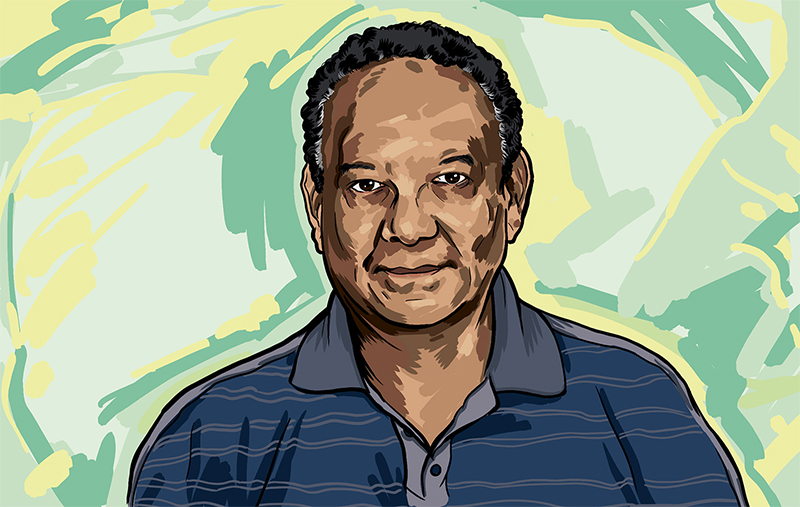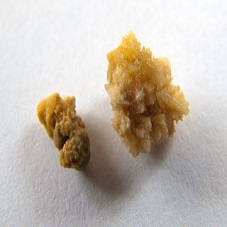A Surgery-Free Way to Treat an Enlarged Prostate

October 02, 2020
Typically, we photograph every patient appearing in HealthU. Because this story was planned during the surge of COVID-19, that contact would have been too risky. Instead, our team took a creative approach and replaced photo shoots with illustrated portraits of patients.
Abdussemed Ibrahim, 71, of Newark, New Jersey, was getting up six or seven times a night to urinate, and he still felt like his bladder wasn't empty. His disrupted sleep left him tired day after day. When traveling, he tried not to drink too much liquid to spare himself from needing to use the restroom, which meant he was often dehydrated.
Like most men over age 40, including his father and his brothers, Abdussemed was suffering from benign prostatic hyperplasia (BPH), or an enlarged prostate. Medication was not enough to relieve his symptoms, and he was reluctant to have surgery. He was using a urinary catheter at least once a day to empty his bladder and obtain full relief.
Thanks to a non-invasive treatment called prostatic artery embolization (PAE), performed by interventional radiologist John S. Demeritt, M.D., at Hackensack University Medical Center, Abdussemed is now comfortable, sleeping well and enjoying life again.
What’s an Enlarged Prostate?
Side effects of an enlarged prostate often begin slowly and can become increasingly bothersome, significantly impairing a man's quality of life. It happens when the prostate, which surrounds the urethra (the tube through which urine leaves the bladder), becomes larger and squeezes or blocks the urethra. This impedes the ability of urine to flow freely.
Medications help many but not all men with an enlarged prostate. Some opt for laser treatment or prostate surgery for relief.
Some patients prefer to not have invasive treatments, which carry a risk of sexual dysfunction and "retrograde ejaculation" (where semen backs up into the bladder). Moreover, some of these procedures may not be good options for men with very large prostates—those weighing more than 100g (a normal prostate weighs 25g).
Non-Invasive Treatment
PAE as a treatment for an enlarged prostate was discovered at Hackensack, and Dr. Demeritt performed the first selective PAE procedure in the world in 2000, threading a tiny catheter directly into the arteries that supply the prostate. Since then, it has been increasingly used and refined, with Dr. Demeritt and his colleagues adding to the research literature about the technique as recently as 2018.
Embolization is widely used to treat other conditions. During embolization for a uterine fibroid, for example, the interventional radiologist seals off arteries supplying blood to the fibroid to shrink it. Using tiny microcatheters, the technique has also been adapted to shrink malignant liver tumors.
"Embolization has found an important niche in the treatment of enlarged prostates," says Dr. Demeritt, explaining that the technique can be used to shrink a prostate by blocking vessels supplying blood to the gland.
Abdussemed read about PAE and contacted a hospital in Portugal to inquire about having it done. They let him know that he could get it much closer to home at Hackensack. In June 2019, he came to the hospital for his PAE procedure. After Abdussemed received local anesthesia, Dr. Demeritt threaded a small catheter through a vessel in his groin, and then an even thinner catheter through the first one directly into to the tiny arteries that supply the prostate. He injected tiny round beads through the catheter, which accumulated in the prostate blood vessels, closing them off. After recovering in the hospital for six hours, Abdussemed went home the same evening with nothing more than a bandage where the catheter was inserted.
The Road to Recovery
Initially, the prostate swells in response to PAE, so Abdussemed continued to self-catheterize. After a few days, he began to feel better, and by three weeks after the procedure, he no longer needed the catheter. His prostate-specific antigen (PSA) level also dropped dramatically over time, from 8 to just 1.8. His urologist told him he is now "like a new person."
Patients typically experience the majority of the benefit of PAE three to six months after the procedure. In addition to shrinking the prostate by up to 20-40 percent, embolization softens the gland so that it can relax as urine flows through the urethra. PAE can be performed in men with even very large prostates—as big as 300g to 400g; there is no upper size limit. It is most effective when the prostate is at least 40g in size because the blood vessels are then large enough to more easily insert the thin catheters.
Most importantly, PAE does not carry an appreciable risk of erectile dysfunction or retrograde ejaculation, making it an attractive option for men who wish to avoid infertility. "PAE preserves normal ejaculation, and that's important to many younger patients," Dr. Demeritt says.
"I was skeptical of PAE at first, but now I think that everyone with an enlarged prostate should consider it," says Abdussemed, whose brother will also be having PAE. "I urinate like a 20-year-old now. My life is so much better!"
Next Steps & Resources
- Meet your source: John S. Demeritt, M.D.
- To make an appointment with John S. Demeritt, M.D. or another provider, call 800-822-8905 or visit our website
The material provided through HealthU is intended to be used as general information only and should not replace the advice of your physician. Always consult your physician for individual care.
Find a doctor near me
Why People Get Kidney Stones

Understand kidney stones? Dr. Chang of Palisades Medical Center explains causes, treatment, and prevention. Learn more and schedule an appointment.
What You Should Know about Prostate Cancer

Prostate cancer information from leading experts. Learn about symptoms, risks, screening, and treatment options. Schedule an appointment today.
Find a doctor near me

Father and Son Overcome Colorectal Cancer Thanks to Timely Screenings
When Don Heddy turned 50 in December 2019, he knew there was one thing he needed to do: schedule a colonoscopy. Like anyone trying to stay on top of their health, he was faithful to that. But he didn’t expect the outcome.

A New Game Plan With Interventional Radiology
Interventional Radiology: Minimally invasive treatment options. Bayshore Medical Center offers advanced care. Learn more and schedule an appointment today.

No Kidney Stones About It
Find kidney stone treatment relief. Fred Klag of Richfield, NJ shares his experience at Palisades Medical Center. Learn more and find a doctor.

Making Dialysis More Bearable
Make dialysis more bearable. Learn how Charles Thomas improved his experience and find support. Call 800-822-8905.
